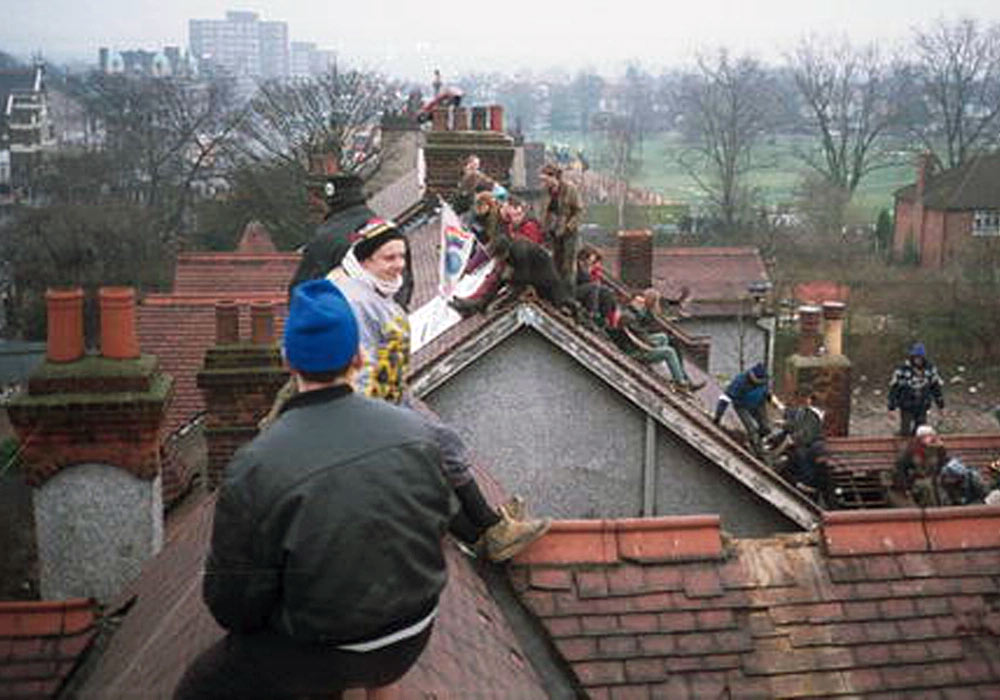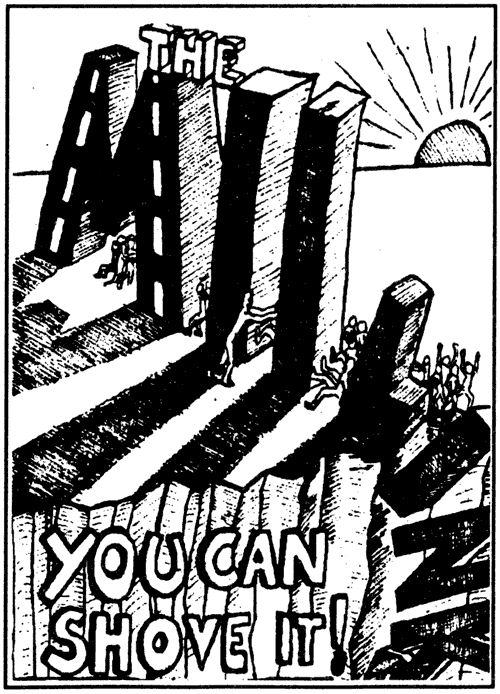
Road-House Blues
Welcome to the largest Road and Housing Protest in Europe
Squall 6, Spring 1994, pg, 13.
The campaign to stop the Hackney M11 Link road bulldozing its way through 350 houses, trees and open space in North-East London has intensified dramatically.
Since construction started in Wanstead in September, squatting protesters, local tenants, school children and pensioners have rallied to peacefully defend their local environment, in the face of increasing hostility from security and the police.

Local residents and campaigners have been busy re-occupying and re-building empty Dept, of Transport (DoT) compulsory-purchase houses along the proposed route, thereby delaying the whole scheme and housing large numbers of people at the same time. For many protesters, the scheme is as much a housing issue as a transport one, with an estimated 1,000 people being evicted from their homes.
At the northern end of the scheme, protest focused on a 250 year old sweet chestnut tree at George Green in Wanstead, which lay in the path of the road. It was occupied by protesters, decorated in ribbons by school children and even protected by rampaging gangs of local old ladies, who on one occasion pushed down 200 metres of security fence to reach it! Even the lollipop lady defiantly climbed aboard a bulldozer to protect, as she saw fit, the children from future car fumes; she was promptly suspended and then sacked from her job.
A Tree or Not a Tree?
That is the question.
On November 11th protesters celebrated after High Court Judge Tuckey demolished DoT lawyers’ evidence and declared, for the first time in English legal history, that the tree was in fact a house. It had a roof (canvas), a door, (blanket) and a letter box - therefore it could not be demolished immediately. The fact that the postman had delivered a letter to the tree earlier that day is believed to have been instrumental in the judge’s decision. The letter, apparently from a concerned green in Cheshire, said “Dear Tree, good luck with the motorway”.
Intimidation:
Petrol and trees don’t mix.
On the night of December 2nd events took a nasty turn when six men approached the tree from three directions. They poured petrol around its base and on the nearby protesters’ bender, setting both alight. Fortunately, they were seen approaching, so no-one was seriously hurt and the fires extinguished. There have been other cases of intimidation against the protesters recently, though as yet, no proof of connection to any of the vested interests involved.
Phone and Run
The protesters have made good use of their ‘telephone tree’ early warning system. In the event of an ‘emergency’, hundreds of people can be mobilised quickly to prevent destruction of houses and trees. Anyone threatened by present or upcoming legislation would do well to create a similar system, as it is cheap and very effective.
The system was put on full alert on the night of the 6th/7th December, when protesters learned that the County Sheriff, police and security would be ‘taking’ the tree at 5.00am. The DoT had gained a possession order and could now take possession of the tree and surrounding common. During that night about 200 concerned protesters arrived from near and far to brave the cold and the rain, to sing songs around the campfire and wonder aloud about what would happen in the morning.
Despite heavy intimidation (for example, ambulances arrived before the 200 police, 150 security and 20 Sheriff’s men) the protest held out for many hours. Ten people were injured, 18 arrested and many were kicked and punched as they were dragged away. By about 1.20pm the last tree occupier was forcibly evicted and a roar of anger went up as a mechanical digger smashed the branches and trunk of the tree - the symbol of the protesters’ campaign and of the Green Belt itself. The extensive TV and newspaper coverage the next day gave graphic descriptions of the tears and the violence inflicted on the peaceful crowd.
Dirty tactics:
Outlawing the right to peaceful protest?
Such police tactics could become even more common if the proposed ‘aggravated trespass’ measures of the Criminal Justice Bill are passed. They were apparently aimed at hunt saboteurs during the Tory party conference, but now road protesters and others are worried about the consequences for their rights to freedom of speech and freedom of assembly. At the Wanstead protests, local police attitudes have hardened and people have been arrested for petty offences like ‘being there’ or for damaging a ‘levelling device’ (a piece of string!) and bail conditions stipulate protesters are not allowed within 50 yards of a road building site.
This type of arrest pre-empts the proposed ‘aggravated trespass’ laws which will “give the police power to direct trespassers to leave land if they have reason to believe that the trespassers will seek to disrupt a lawful activity”. According to the Guardian (3-12-93) the Home Office has recently affirmed that the law will not be limited only to hunt saboteurs, and that they are formulating a “general plan for aggravated trespass”.
The future is just around the corner, left at the lights.
Although many of the local population are now resigned to the road (“double glazing will save me”), the protesters are confident they will eventually win the battle. So far only about 50 of the 350 houses have been destroyed while the contractors, Norwest Holst, are already in financial difficulties. The squatting and rebuilding of empty properties has contributed to the delaying of the scheme and there are still three construction contracts (out of four) to be awarded. The campaigners are confident that the bad publicity and losses suffered by Tarmac at Twyford Down (£1.9m) combined with the current M11 protests may well stall any would-be bidders.
The chestnut tree appears to be just the beginning of what promises to be a long battle. Every blade of grass, every empty house along the proposed route will be defended, say the protesters. They hope that their actions will put a stop to the Government’s incredibly expensive and destructive road programme which, if continued will:
• Destroy 160 sites of special scientific interest.
• Destroy 800 scheduled monuments.
• Demolish thousands of homes
• Consume millions of tonnes of aggregate (often mined from eco-sensitive areas like natural parks)
• Cost you and I £23 billion, while starving public transport of funding, so forcing yet more traffic on to the roads.
• Increase air pollution, road accidents and out-of-town developments like superstores and business parks.
The Free State of Wanstonia.
The recent Universal Declaration of Independence of Wanstonia (the area of houses and woodland immediately threatened by the road) and the two recent mass occupations of the site have kept this road scheme well in the public eye.
Wanstonia is believed to be the first country to ban logging completely and one of the first to institutionalise the squatting of abandoned, empty property. (It is thought that the highly successful Frestonia, West London in 1977 was the first.) All roads and cars have been banned, as have political parties, leaders and state bureaucracy.
The final showdown inevitably came on the morning of 16th February. The protesters barricaded themselves into the line of houses facing destruction, using all manner of ingenious devices to delay the invaders. Their conduct was impeccable non-violent direct action - as opposed to the amphetamine-enhanced posturing of the Tactical Support Group (read Paramilitary Police) who ran around the site like foxhounds after blood. Millions of taxpayers all over the country watching the evening news saw £250,000 of their money spent on 1,000 police and bailiffs knocking down six houses to regain control of 300 yards of potential road space.
The protests have now moved south to Leytonstone, to continue the embarrassment of building a £200million link which will knock an estimated seven minutes off commuters’ journey time. On March 15th the campaigners begin Operation Roadblock, a national rota of 100 people a day to peacefully resist the scheme.
If you would like to get involved in Operation Roadblock and the Beat the Bulldozer Pledge, please contact 081 558 2638.
The campaign have published a selection of the letters sent to the chestnut tree called ’Dear Tree’. It costs £2 from the
No M11 Link Campaign,
PO Box 956,
London E11 1AA.
Related Articles
Towers Of Strength - Claremont Road, East London; inside Europe's longest eviction. Report and interviews with protesters against the M11 Link Road - Squall 9, Jan/Feb 1995
For a menu of many other Squall articles about the Anti-Roads Movement, including protest camps, Reclaim The Streets and more click here
Recommended Viewing
Life In The Fast Lane - The No M11 Story (1995) - viewable for free online on YouTube - produced and directed by Mayyasa Al-Malazi and Neil Goodwin
